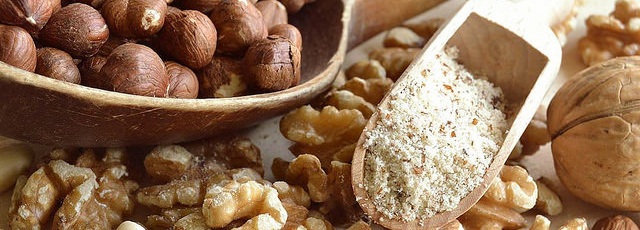The undeniable fact is that almonds are one of the most popular and beneficial food for any healthy and balanced diet. The endless useful qualities they have, combined with their unique taste make these crunchy nuts irreplaceable.
Almonds have been mentioned as early as the 1400 BC when they were first referred to in the Bible’s book of Numbers. So it is not surprising that this wildly cultivated seed has lots of amazing health benefits and could positively influence you in many ways.
Indigenous to the Mediterranean region of the Middle East and up to the Yamuna River in India, almonds were later made known by humans in ancient times as far as Northern Africa, Southern Europe and more recently to the United States that is now the main producer of almonds in the world.
In countries like Iran, India, Pakistan, Afghanistan and Central Asia the almond is known as bādām. Germans call it Knackmandel and in Portuguese – amêndoa.

The Drosselmeyer Nutcracker. Visit our Shop
Basic nutrient profile:
A 1 ounce (28 grams, or small handful) serving of almonds contains:
Fiber: 3.5 grams.
Protein: 6 grams.
Fat: 14 grams (9 of which are monounsaturated).
Vitamin E: 37% of the RDA.
Manganese: 32% of the RDA.
Magnesium: 20% of the RDA.
Almonds are packed with iron, magnesium, zinc, copper, potassium, Vitamin E, B vitamins riboflavin, essential mineral calcium and Vitamin B6. Not only this, but they are rich in fiber, monounsaturated fats, and polyunsaturated fats, that might help lower your LDL cholesterol. They are also a healthy source of protein and an amazing snack since only 10- 15% of an almond’s calories are actually absorbed. The reason is that the fat they contain is too difficult to access and break down.
Lifecycle
From November to February, almond trees go through a period of dormancy due to the cold weather. In the period between February to March – the almond tree buds start to bloom. When they are ready, they are pollinated with the help of bees, as these trees are not self-pollinating. During the period from March to June, the almonds develop – their shell hardening and kernel forming. From July to August the hull dries and splits open, revealing the shell protecting the nut. The nut is left to dry naturally in this shell before they are harvested. The harvesting period is from August to October. It is done by picking the almond nuts from the branches you can reach or if you need to – mechanical tree “shakers” that harvest the almonds by vigorously shaking them to the ground can be used.
Around the world
Almonds are widely used all around the world, especially in cosmetics, cooking and making of sweets. In France, they use almonds in desserts like macaroons, marzipan and the famous almond-cream-filled puff pastries called Galette de Rois. In Greece, they use ground, blanched almonds as a base in a variety of desserts called amygdalota. Iran produces both sweet and bittersweet almond varieties. It is common there to consume a snack called chaqale bâdam – a green almond dipped in sea salt. As the USA is the dominant producer of almonds in the world it is not a surprise the variety of products Americans use almonds in. From flour, milk, and butter to oil – they really enjoy them. A drink made from almonds mixed with milk is often served in important ceremonies in Morocco. Moroccans also love almonds in a form of a paste that they later use as pastry filling in several types of desserts. In Southeast Asia, almond oil is very popular for its health and beauty benefits.
Health benefits
1. Almonds help maintain a healthy heart
A healthy lifestyle is crucial in preventing cardiovascular deceases and premature death. Almonds can be very helpful in this regard, by playing an essential role in your diet. According to the U.S. Food and Drug Administration, “Scientific evidence suggests, but does not prove, that eating 1.5 ounces per day (43 grams) of most nuts, such as almonds, as part of a diet low in saturated fat and cholesterol may reduce the risk of heart disease.”
2. Almonds help lower your cholesterol levels
Since almonds contain monounsaturated fats and polyunsaturated fats they are ideal in helping you lower your LDL lipoproteins (the “bad” cholesterol).
A study published in the Journal of American Heart Association (JAHA) found that substituting a high – carbohydrate snack with a recommended daily serving of almonds (1.5 oz./ 42 g) might help in preventing cardiometabolic diseases in healthy individuals.
A recently released Canadian Cardiovascular Society Guidelines recommend regular consumption of nuts as a way of bettering your cholesterol levels and reducing the risk of heart attack and stroke.
3. Almonds could lower your blood pressure
High blood pressure is one of the main reasons for heart attacks, strokes and kidney failure. Almonds provide you with 20% the recommended dose of Magnesium you need to keep your blood pressure under wraps.
4. Almonds “Feeds” your muscles
If you ever wonder what the best after workout snack is, look no further. Almond butter is not only a healthy and delicious source of protein, but it has potassium which is something your body and muscles need in order to recover after intense physical activity.
5. Almonds help in keeping you alert
Thanks to the riboflavin and copper that almonds contain – two minerals that are essential in keeping us energized, almonds can be a good way to boost your energy levels.
There is also a study suggesting that almond consumption at a midday meal can reduce the post-lunch dip in memory.
6. Almonds help to fight inflammation
More magnesium equals less inflammation. Since almonds are a rich source of magnesium it is not a surprise that they might help with keeping it contained. The presence of inflammation is increased by a CRP (C- reactive protein) which is substance found in your blood. It is known that the lack of magnesium can suggest the elevated presence of CRP in your body. According to the Linus Pauline Institute – a recommended dose of magnesium (320 milligrams for a woman and 420 milligrams for a man) is necessary to prevent high CRP levels.
7. Almonds help managing blood sugar levels
Almonds have a low- glycemic index which makes them perfect for people with glucose intolerance or Type 2 diabetes.
A 10- week study of 20 Chinese adults with T2D and mild hyperlipidemia showed the effects of a four weeks diet containing 2 ounces (56 grams) almonds per day versus a regular, controlled diet that did not contain any. It showed that by lowering fasting insulin and glucose, almonds helped in improving glycemic control.
8. Almonds prevent diabetes
People who regularly eat nuts, such as almonds and walnuts are less likely to develop diabetes. This is due to their ability to decrease the after-meal spike of your blood sugar levels, therefore keeping it stable and in the norm.
9. Almonds help with controlling body weight and cravings
In order to control your body weight, you have to keep a healthy and balanced diet. As they are high in protein and fiber – almonds are ideal for keeping you fuller and satisfying your cravings for a longer period of time, which can greatly minimize your calorie intake for the day.
A 4- week study with 137 participants was observed. A daily serving of 43 grams of almonds was added to their diet as snacks, reducing their appetite during their main meal of the day.
10. It is a beauty and skin care must have
Almonds and more specifically almond oil works wonder when it comes to your beauty regimen. It is super versatile and can be used on your skin, hair and is even good for your teeth as it contains calcium and phosphorus. The olein glyceride linoleic acid in almonds helps with acne prone skin, blackheads and moisturizing the skin. It can reduce dark circles and puffy eyes. The magnesium that almonds contain, promotes hair growth and vitamins like B1, B2 and B6 strengthen and nourishes it.
Image Copyright: Amazing Almonds, License: CC BY 2.0



